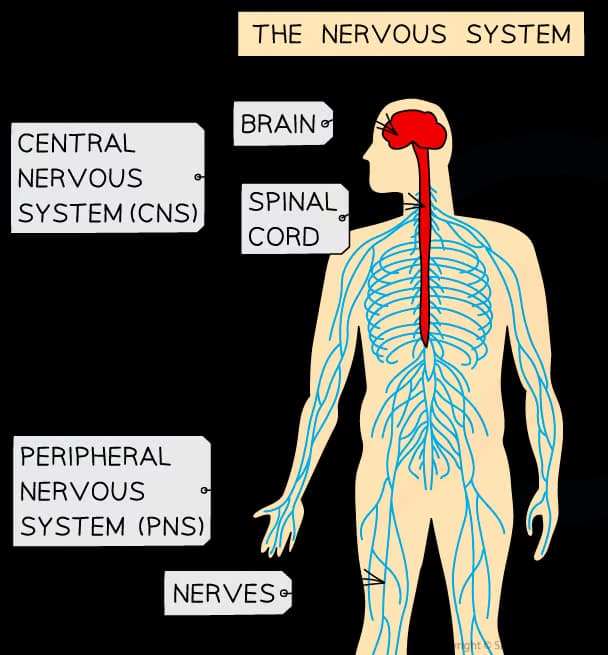Syllabus Edition
First teaching 2017
Last exams 2026
The Divisions of the Nervous System (AQA A Level Psychology): Revision Note
Exam code: 7182
The central nervous system
The human nervous system is divided into two parts:
The central nervous system (CNS)
The peripheral nervous system (PNS)
These two systems are connected and work together so that the whole human nervous system functions effectively
The two systems collect information from inside the body and from the surrounding environment
Both systems process this information and then dispatch instructions to the rest of the body, facilitating an appropriate response, e.g.
The PNS contains a huge network of spinal and cranial nerves
These nerves link to the brain and spinal cord
Sensory receptors in the PNS process internal and external changes
This information is then sent to the CNS via afferent sensory nerves
The CNS is made up of the brain and the spinal cord
The brain is central to maintaining life and has many functions including:
regulating body temperature, heart rate and breathing
language (production and understanding)
coordinating movement
coding sensory data via the sensory organs (e.g. the skin) and the environment
problem-solving and planning
The brain's cerebral cortex is the most sophisticated part of the brain
The cerebral cortex consists of the outer layer of the brain (like a shower cap that covers the brain)
It also carries out essential functions of the brain such as
memory, thinking, learning, problem-solving, consciousness, sensory functions
The cerebral cortex is a key marker that distinguishes humans from animals
The spinal cord ensures that signals from the brain are transmitted to the rest of the body via the PNS
The brainstem connects the brain to the spinal cord

The peripheral nervous system: somatic & autonomic
The PNS transmits messages throughout the whole body from the brain and also relays messages back to the brain
The PNS is divided into two sections:
The somatic nervous system (SNS)
The autonomic nervous system (ANS)
The somatic nervous system
The SNS transmits and receives messages from the senses apart from sight
The retina and optic nerve are connected directly to the brain
The other senses — sound, smell, taste and touch — travel via the SNS to communicate with the brain, e.g.:
touch information from the skin (e.g. the texture of velvet)
taste information from the tongue (e.g. the flavour of ketchup)
The sense of touch below the neck uses the SNS to communicate with the spinal cord, which then relays relevant signals to the brain
The SNS directs the muscles to move appropriately
Thus, the SNS controls voluntary, conscious movements, e.g.
throwing a ball
running across a road to get out of the way of an oncoming car
The SNS is also responsible for the reflex arc, which, although automatic (not conscious), still involves the use of muscle movement

The autonomic nervous system
The ANS transmits and receives information from the organs, e.g.
heart-rate
breathing
the stress response
digestion
sexual arousal
The ANS is involuntary; it cannot be controlled consciously
The ANS can be further subdivided into:
the sympathetic nervous system (SPNS)
the parasympathetic nervous system (PSNS)
The sympathetic nervous system
The SPNS is associated with the 'fight or flight' response in tandem with the endocrine system as follows:
The SPNS prepares the body for physical activity when the hypothalamus detects a stimulus which requires attention/action, e.g.
running away from a threat
standing and facing the threat
preparing to fight the threat
The SPNS is triggered when the body is in an 'alert' state, e.g.
when crossing the road
when a noise is heard late at night
Adrenaline is released from the adrenal glands to fuel any physical activity required of the body along with other physiological changes, e.g
accelerated heart rate
widened bronchial passages for increased breathing capacity
decreased activity of the large intestine
pupil dilation
sweating
The SPNS thus enables a fast, automatic response to a possible threat or dangerous situation (but it can also occur when someone is highly elated or excited)
The parasympathetic nervous system
The PSNS is popularly known as the 'rest and digest' system:
The PSNS is the body at rest which (to preserve energy) is its usual state
The PSNS helps to conserve the body's activity levels and energy by decreasing activity which may be needed later
The PSNS regulates bodily functions like digestion and urination
The PSNS slows heart and breathing rates and lowers blood pressure as the body enters a state of relaxation
Relaxation enables the body to go into 'standby' (recovery mode)
The more time spent in a PNS state, the healthier a person is likely to be

Examiner Tips and Tricks
Make sure you don't get these terms confused (particularly as they - unhelpfully - sound very similar). Learn the above diagram to help you understand how the human nervous system is organised.

Unlock more, it's free!
Did this page help you?